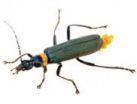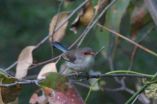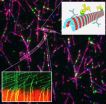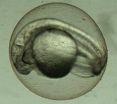(Press-News.org)
New antibiotic and anti-cancer chemicals may one day be synthesised using biotechnology, following CSIRO's discovery of the three genes that combine to provide soldier beetles with their potent predator defence system.
CSIRO researchers, and a colleague at Sweden's Karolinska Institute, published details of the gene identification breakthrough and potential applications recently in the international journal Nature Communications.
"For the first time, our team has been able to isolate and replicate the three genes that combine to make the potent fatty acid that soldier beetles secrete to ward off predators and infection," said CSIRO Ecosystem Sciences research leader Dr Victoria Haritos.
"This discovery is important because it opens a new way for the unusual fatty acid to be synthesised for potential antibiotic, anti-cancer, or other industrial purposes," Dr Haritos said.
Soldier beetles exude a white viscous fluid from their glands to repel potential attacks from predators, as well as in a wax form to protect against infection.
The team found this fluid contains an exotic fatty acid called dihydromatricaria acid, or DHMA, which is one of a group called polyynes that have known anti-microbial and anti-cancer properties.
While DHMA and similar polyyne fatty acids are found in a wide variety of plants, fungi, liverworts, mosses, marine sponges and algae, these compounds have proved very difficult to manufacture using conventional chemical processes. However, Dr Haritos and her team have developed a way to achieve this.
"We have outlined a method for reproducing these polyyne chemicals in living organisms like yeast, using mild conditions" Dr Haritos said.
Soldier beetles are the only animals reported to contain DHMA. This, together with the observation that the beetles forage on plants (such as daisies) which contain a lot of these types of fatty acids, led to previous incorrect conclusions that the DHMA in soldier beetles was derived from their diet.
"Through our research and the gene differences we have discovered, we now know soldier beetles have evolved this same defensive compound entirely independently of its production in plants and fungi," Dr Haritos said.
INFORMATION:
Gene find turns soldier beetle defence into biotech opportunity
2012-11-08
ELSE PRESS RELEASES FROM THIS DATE:
Cedars-Sinai research: Preclinical muscular dystrophy data shows promise
2012-11-08
LOS ANGELES — Nov. 7, 2012 – Cedars-Sinai Heart Institute researchers have found that an experimental compound may help stem the debilitating effects of muscular dystrophy by restoring normal blood flow to muscles affected by the genetic disorder.
The researchers studied HCT 1026, a new type of molecule in which nitric oxide is chemically attached to a standard anti-inflammatory agent, in a preclinical model of muscular dystrophy. Results suggest HCT 1026 may be beneficial for the treatment of Duchenne muscular dystrophy, which begins in early childhood, and Becker muscular ...
Capturing carbon with clever trapdoors
2012-11-08
University of Melbourne Engineers have developed a novel method of collecting and storing carbon dioxide that will reduce the cost of separating and storing carbon dioxide.
The quest to capture carbon dioxide is crucial to a cleaner future and once captured, carbon dioxide can be compressed and safely stored.
It is also a useful source for chemical manufacture. However, current processes are inefficient and require several stages of refining and extraction before a pure form of carbon dioxide is produced.
One method of capturing carbon dioxide is through molecular ...
Historic coral collapse on Great Barrier Reef
2012-11-08
Australian marine scientists have unearthed evidence of an historic coral collapse in Queensland's Palm Islands following development on the nearby mainland.
Cores taken through the coral reef at Pelorus Island confirm a healthy community of branching Acropora corals flourished for centuries before European settlement of the area, despite frequent floods and cyclone events. Then, between 1920 and 1955, the branching Acropora failed to recover.
Scientists from the ARC Centre of Excellence for Coral Reef Studies at the University of Queensland say the rapid collapse of ...
The right pace of neural development protects against autism and intellectual disability
2012-11-08
Neurodevelopmental disorders such as intellectual disability and autism spectrum disorders are marked by mutations that impair signaling between neurons. These mutations cause key brain circuits involved in learning and memory to develop too quickly, leading to long-lasting behavioral and cognitive deficits, according to a study published by Cell Press in the November 9th issue of the journal Cell. The findings could pave the way to new treatment strategies for severe forms of neurodevelopmental disorders.
"We have provided perhaps the first evidence that acceleration ...
Fairy-wren babies need password for food
2012-11-08
AUDIO:
This is a fairy-wren incubation call.
Click here for more information.
It's always a good idea to listen to your mother, but that goes double for baby fairy-wrens even before they are hatched.
If those fairy-wren babies want to be fed, they need to have a password—a single unique note—taught to them by their mothers from outside the egg. The nestlings incorporate that password right into their begging calls, according to researchers who report their discovery online ...
Scientists uncover secrets of how intellect and behavior emerge during childhood
2012-11-08
JUPITER, FL – Scientists from the Florida campus of The Scripps Research Institute (TSRI) have shown that a single protein plays an oversized role in intellectual and behavioral development. The scientists found that mutations in a single gene, which is known to cause intellectual disability and increase the risk of developing autism spectrum disorder, severely disrupts the organization of developing brain circuits during early childhood. This study helps explain how genetic mutations can cause profound cognitive and behavioral problems.
The study was published in the ...
Meet Xenoceratops: Canada's newest horned dinosaur
2012-11-08
Ottawa, Canada (November 8, 2012) – Scientists have named a new species of horned dinosaur (ceratopsian) from Alberta, Canada. Xenoceratops foremostensis (Zee-NO-Sare-ah-tops) was identified from fossils originally collected in 1958. Approximately 20 feet long and weighing more than 2 tons, the newly identified plant-eating dinosaur represents the oldest known large-bodied horned dinosaur from Canada. Research describing the new species is published in the October 2012 issue of the Canadian Journal of Earth Sciences.
"Starting 80 million years ago, the large-bodied ...
UMass Amherst cell biologists identify new protein key to asymmetric cell division
2012-11-08
AMHERST, Mass. – Recently biologists at the University of Massachusetts Amherst led by Wei-lih Lee have identified a new molecular player in asymmetric cell division, a regulatory protein named She1 whose role in chromosome- and spindle positioning wasn't known before. Asymmetric cell division is important in the self-renewal of stem cells and because it ensures that daughter cells have different fates and functions.
When a fertilized egg develops in a fruit fly or a human being, the number of asymmetric cell divisions must be precisely balanced by symmetric cell divisions, ...
Scientists reveal key protein interactions involved in neurodegenerative disease
2012-11-08
JUPITER, FL, November 8, 2012 – Scientists from the Florida campus of The Scripps Research Institute (TSRI) have defined the molecular structure of an enzyme as it interacts with several proteins involved in outcomes that can influence neurodegenerative disease and insulin resistance. The enzymes in question, which play a critical role in nerve cell (neuron) survival, are among the most prized targets for drugs to treat brain disorders such as Parkinson's disease, Alzheimer's disease and amyotrophic lateral sclerosis (ALS).
The study was published online ahead of print ...
Unique spinal nerve cell activity discovery announced by University of Leicester biologists
2012-11-08
Scientists from the University of Leicester have hit upon unique forms of spinal nerve activity that shape output of nerve cell networks controlling motor behaviours.
The breakthrough in the Department of Biology at the University of Leicester is announced today (5pm GMT on Thursday Nov 8) in the journal Current Biology. The three- year study was funded by the Biotechnology and Biological Sciences Research Council (BBSRC).
Although the neural basis of motor control has been studied for over a century, the processes controlling maturation of locomotor behaviours – like ...





